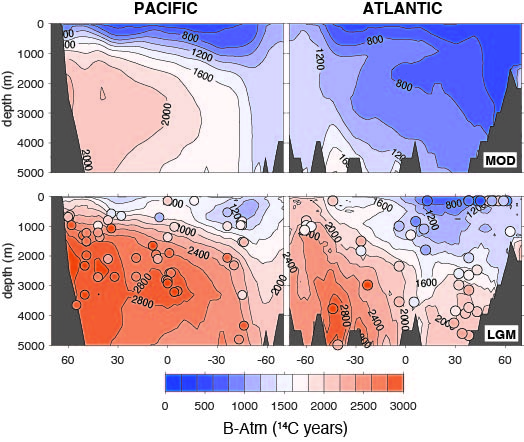Research
Earth System Dynamics, Ocean Circulation and Biogeochemical cycling
Zonally averaged ocean-atmosphere radiocarbon offsets (B-Atm) for the Last Glacial Maximum and modern seawater (Key et al., 2004), showing a clear reduction in 'ventilation' of the glacial ocean (see Skinner et al., Clim Past, 2023).
My research looks at the role of the ocean circulation in past climate change, including in particular its impact on the hydrological- and biogeochemical cycles. Ultimately this work aims to provide a geological perspective on the climate system and its dynamics on relatively short time-scales (10-104 yrs); time-scales that are relevant to past and future human activities. I use a range of geochemical, sedimentological and micropalaeontological methods to infer past hydrographic changes (including stable and radiogenic isotope and trace element analyses). Ongoing research projects include investigations of: 1) the causes and consequences of abrupt oceanographic and climate change on the southern Iberian Margin during the late Pleistocene; 2) the deep ocean’s temperature, oxygenation and carbonate ion response to rapid climate change during MIS 3 and MIS 6 (and its link to atmospheric CO2); 3) laser-ablation analysis techniques to understand rare earth element and redox sensitive element cycling; 4) the role of the ocean circulation in glacial-interglacial CO2 change and the evolution of the marine radiocarbon inventory across the last deglaciation; and 5) the hydraulics of the last Lake Agassiz ‘super-flood’.
Some aspects of my research are outlined below. More details can be found at this webpage.
Glacial-interglacial climate change
The dominant mode of climate variabiity during the Quaternary/Pleistocene has been characterised by ~100,000 year oscillations between glacial- and interglacial climate states. It seems clear that these climate cycles have been paced by changes in the seasonality of solar radiation (i.e. insolation), but it is also clear that this pacing was made possible, and was amplified by strong positive feedbacks internal to the climate system. Albedo- (ice sheet) and carbon cycle (i.e. carbon dioxide) feedbacks appear to have been foremost amongst the contributing feedbacks. Despite over a century of research, it remains unclear exactly how these feedbacks were triggered and coordinated by insolation changes. Ongoing research is seeking to address just this question, and to use the ‘zoo’ of past glacial and interglacial climate states as a natural laboratory in which to investigate the context dependence of climate feedbacks, which ultimately must underpin the non-linearity that Quaternary glacial-interglacial dynamics exemplify.
Abrupt climate change
The recovery of very high-resolution records of climate variability from the polar ice-sheets, lakes, speleothems and high sedimentation-rate marine sediments has fundamentally changed our perspective on global climate change by revealing the existence of very rapid and intense climate changes in the past. Such records serve to underline the fact that significant climatic transitions may arise from the interaction of parameters that are completely internal to the climate system, emphasizing the importance of feedbacks in the climate system. One key aspect of the abrupt climate variability recorded during past glacial periods is its ‘bi-polar’ pattern, with abrupt climate swings in the North Atlantic region coincident with more gradual and subdued changes over Antarctica. The canonical explanation for this inter-hemispheric coupling is the ‘bipolar seesaw’ mechanism, whereby changes in the strength of the Atlantic overturning circulation result in changes in the interhemispheric heat transport. A sudden reduction of the overturning circulation in the North Atlantic (triggered by a massive iceberg/freshwater release for example) is thus thought to result in a reduction in the northward heat transport to the Northern Hemisphere and a concomitant increase in the southward heat transport to the Southern Hemisphere. The transport of this ‘excess’ heat across the Southern Ocean to Antarctica is presumed to take some time, hence the slower response of Antarctica. The bipolar seesaw mechanism is a neat and highly explanatory theory. It builds on ideas of hysteresis and bi-stabilty in the overturning circulation. However, much remains to be learned about how well this theory fits with reality, what it tells us about the stability of the ocean circulation, and how its behaviour might depend on background climate conditions and/or the character of forcing applied. Current research is looking at the response of the tropical- and North Atlantic, and the Southern Ocean, to these abrupt climate swings, as well as the existence and character of rapid climate change during different climatic regimes, including interglacial (warm) climates like today’s.
Radiocarbon and past carbon cycle change
By measuring the radiocarbon age of bottom-dwelling foraminifera, and comparing this with the radiocarbon content of the contemporary atmosphere, it is possible to infer past changes in the exchange of carbon dioxide between the ocean and the atmosphere. Radiocarbon measurements from the deep North Atlantic have underlined the role of the overturning circulation in effecting rapid and intense changes in regional climate and carbon cycling across the Bolling-Allerod and the Younger Dryas events (~11-15,000 years BP), and further data from around the globe have confirmed an increase in the mean residence time of carbon dioxide dissolved in the deep glacial ocean. Ongoing work is seeking to combine these observations with auxiliary proxies that may help to quantify the impact on the marine respired carbon inventory, and therefore atmospheric CO2.
The Marine Isotope Stage stratigraphy
On multi-millennial timescales the marine oxygen isotope record may provide a powerful stratigraphic reference of global relevance. However, given the variability of temperature and water-δ18O in the world's oceans (the distribution of which is controlled by the ocean circulation and hence climate), it need not be globally synchronous on 'sub-orbital' timescales. Deep-water temperature estimates across glacial Terminations, in different ocean basins, indicate that the development of our stratigraphic systems at the high temporal resolution that is now necessary is inherently bound up with the very climate changes that we use those stratigraphic systems to study. This presents a serious challenge that will have to be met if we are to make full use of the globally distributed high-resolution records that now exist, and if we are to eventually solve the 'mystery' of insolation- and carbon dioxide forcing on long-term climate evolution.
The last Lake Agassiz superfood, and the '8.2 kyr event'
Late Quaternary deposits in the Moose River Basin (James Bay Lowlands) area of northern Ontario (Canada) consist of a succession of glacial tills with interceding interglacial deposits, which culminate in a sequence that corresponds to the last glacial cycle. At the top pf this sequence is a ‘deglacial succession’ that records the demise of a vast pro-glacial lake (roughly the size of England) that had pooled against the dwindling Laurentide ice-sheet. Ongoing work is targeting reconstructions of the hydraulic and sedimentary conditions that led to the deposition of the ‘flood deposits’ , as well as the occurrence of sudden changes in the provenance of siliciclastics incorporated into these deposits.
Publications
Recent publications can be found in the publications database here
Teaching and Supervisions
1A 'Tipping points'
Pt II (C4) Climate option
PtIII IDP2, Earth System and Climate Change
Svetlana Radionovskaya (PhD): 'The Role of the Ocean in MIS 4 Climatic Changes and Atmospheric CO2 Variability: a Geochemical Fingerprinting Approach' (graduated 2023)
Mohamed Ezat (independent research fellowship, Royal Society/NRC): 'Deglacial radiocarbon ventilation of the Nordic Seas' (moved to research position Tromso)
Natalia Vazquez-Riveiros (PDRA, AXA/Newton Trust): 'Climate variability during Marine Isotope Stages 7 and 8' (moved on to permanent position IFREMER)
Julia Gottschalk (PhD): 'The role of the Southern Ocean in millennial-scale atmospheric CO2 changes' (graduated 2015, Professor).
Emma Freeman (PhD): 'Radiocarbon and stable carbon isotope constraints on the Atlantic Ocean ventilation over the last deglaciation' (graduated 2015, moved into environmental consultanting).
Sophie Lawrence (MRes): 'A multi-proxy reconstruction of Heinrich Stadial 4 on the Iberian Margin' (graduated 2017).
Masters research projects and internships: David Wilson (MIS 3 foraminifera), Vickie Rennie (MIS 6 IRD), Emma Freeman (radiocarbon), Chloe Hemingway (d11B), Margaux Brandon (REE, U/Ca), Mark Atree (Lake Agassiz), Guy Lomax (Tropical circulation), Alistair Graham (Lake Agassiz), Sarah Burnham (surface ocean d13C), Lauren Broadfield (benthic Mg/Ca), James Kershaw (benthic Mg/Ca, Mg/Li), Rachel Nash (MOW radiocarbon), Phil Slay (HS1 radiocarbon), Ana Marza (ML applied to regional C14 calibrations).
Other Professional Activities
Dos and Tutor for Postgraduate Admissions, Magdalene College.


